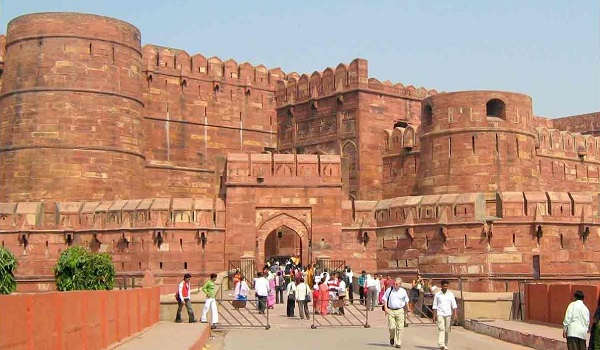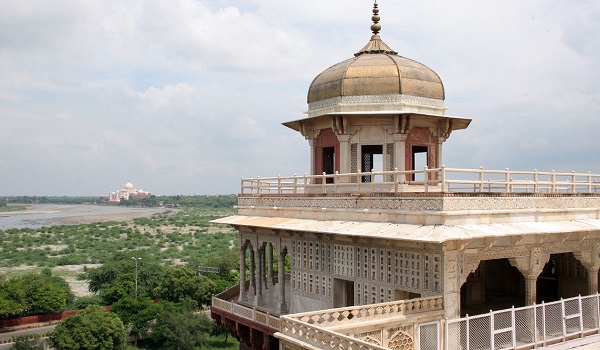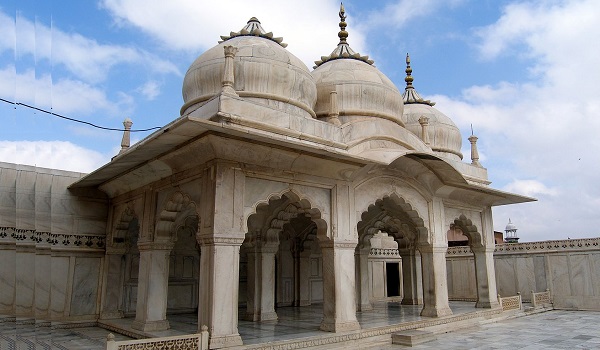Fast Facts
Location: Agra, Uttar Pradesh
Built By: Akbar
Built in the Year: 1573
Purpose: Main residence of the Mughals
Area: 380,000 square meter
Current Status: The fort is a UNESCO World Heritage site
Visit Timing: Sunrise to sunset
Entry: Entry to Agra Fort is allowed through the Amar Singh Gate only

Agra Fort was built in the year 1573 under the reign of Akbar – one of the greatest Mughal Emperors. It took more than 4000 workers and eight years of hardship to complete the fort. Knowing the significance of its location, Akbar built the fort to make it the main residence of the Mughals. The fort remained as the main residence of the emperors belonging to the Mughal dynasty until the year 1638. The fort houses numerous impressive structures like the Jahangir Mahal, Khas Mahal, Diwan-i-Khass, Diwan-i-Am, Machchhi Bhawan and Moti Masjid. In 1638, the capital of the Mughal dynasty was moved from Agra to Delhi, causing the Agra Fort to lose its status as the main residence of the Mughal emperors. The fort is separated from its sister monument Taj Mahal by just 2.5 kilometers. Often described as the walled city, Agra Fort is a UNESCO World Heritage site. Today, the fort is a major tourist spot and attracts many tourists from all over the world.
History of the Fort
Agra Fort is known for its rich history. The fort has been owned by many emperors and rulers in the past, undergoing many changes in its appearance. It all began in the year 1526 when the first battle of Panipat was fought between Babur and Ibrahim Lodi of the Lodi dynasty. When Babur defeated Ibrahim Lodi, he made the fort and the palace of Ibrahim Lodi as his home. He then modified the fort by building a huge step well (baoli) inside. The fort soon became an important monument to the Mughals. In fact, Babur’s successor, Humayun’s coronation took place at the fort in the year 1530.
Soon emperors from other dynasties started eyeing the fort and efforts to win over the same began. In 1540, Sher Shah Suri of the Sur Empire waged a war against Humayun and defeated him at Bilgram. Sher Shah Suri took over the ownership of the fort from Humayun and made minor changes to it, so as to suit his own architectural taste. The fort stayed with the emperors of the Sur dynasty for the next 15 years. In 1555, Humayun managed to recapture Agra and with it the fort as well. But a year later, Hemu Vikramaditya, the general and military commander of Adil Shah Suri (final emperor of the Sur dynasty) captured Agra. He pursued the fleeing army to Delhi and the Battle of Tughlaqabad ensued between him and Tardi Beg Khan, the military commander of the Mughals.
Tardi Beg Khan lost the battle convincingly and Hemu Vikramaditya crowned himself the king. However, on November 5 1556 and barely a month into the kingship of Hemu, Akbar, along with his army, marched into Delhi and defeated the forces of Hemu. The fort once again belonged to the Mughals, but was fast disintegrating. Back then, it was known as Badalgarh and was built with bricks alone. Realizing its historical and situational significance, Akbar decided to rebuild it with red sandstone.
During the reign of Shah Jahan, the fort was modified considerably and took the current form. Shah Jahan destroyed some of the edifices within the fort and rebuilt it as per his own architectural taste. During the early 17th century, the fort was captured by the Maratha Empire.During this period, the fort saw many owners including various Maratha emperors and their enemies which included a host of Mughal emperors. In 1761, the Marathas underwent a massive defeat at the hands of Ahmad Shah Durrani, founder of the Durrani Empire. The emperors of the Durrani dynasty made the fort their home until 1785. In 1785, the fort was regained by the Marathas under the reign of Mahadji Shinde. The Marathas then lost their battle against the British in the Second Anglo-Maratha War and with it the fort. The British then enjoyed the comfort of the fort until it was handed over to the government of India in 1947.
Layout of the Fort
The fort, when viewed from above, has a semicircular shape. The base of the fort faces the bank of the river Yamuna. The Agra Fort is enclosed by a double battlemented massive wall of red sandstone. This wall is about 2 kilometer in perimeter and is interrupted by graceful curves and lofty bastions. The walls of the fort are a massive seventy feet high. The fort stretches for almost 2.5 kilometers. It has four gates (one on each side). Out of the four gates, the Delhi gate and Lahore gate are the most prominent ones. The Lahore gate was later renamed as Amar Singh Gate. Akbar used the Delhi gate as his main entrance and the gate also served as a security against the invaders. There is also an inner gateway known as the Elephant Gate. The entrances were built in such a manner that the invaders found it difficult to enter the fort even with the help of war elephants. The Indian army still uses the Delhi gate for security purposes.
The fort has various palaces and halls. Among the palaces, the prominent ones are Macchi Bhavan, Khas Mahal and Shah Jahani Mahal. The Amar Singh gate leads to the courtyard. The magnificent Diwan-I-Am (Hall of Public Audience) is on the right hand side. A little further lay the royal pavilions, which houses the famous Nagina Masjid and Mina Masjid. The fort also has royal baths made out of marbles, which were used by the princesses. Also, places of worship and a private market place for the ladies were built within the fort. At the base of the fort, a secret passage was dug in an attempt to access it with ease, during times of emergency. Other attractions of the fort include a grape garden, a jasmine tower, a mirror palace (Shish Mahal), courtrooms and the ruins of Akbar’s once magnificent palace. It is said that the fort once housed five hundred beautiful looking buildings. Unfortunately, many of those buildings were destroyed at different time periods for various reasons.
Architecture
Bricks formed the base of Agra Fort’s structure. Red sandstone was brought all the way from Rajasthan and that was laid on the external surfaces. Back then, the entire fort was built using the red sandstone. This appearance of the fort underwent a major change during the reign of Shah Jahan. Unlike his grandfather, Shah Jahan was smitten by the beauty of white marble. Hence, he destroyed many structures within the fort, only to rebuild them using white marble. Shah Jahan was made to spend his final days in the Musamman Burj of the Agra fort, which was built by him.The Musamman Burj is located on the left of the Khaas Mahal. It is a beautiful octagonal tower with an open pavilion. It is said that Shah Jahan used to view the Taj Mahal from this very place.
When the British took over the ownership of Agra Fort, much more changes were made to the fort. They destroyed many structures and edifices with historical significances, citing political reasons and for raising barracks. The structures that managed to survive showcase the real complexity and workmanship of Mughal architecture. Fine examples of the Mughal architecture within the fort are the Delhi Gate, Amar Singh Gate and the Bengali Mahal. These structures not only represent Mughal architecture, but are also fine examples of Akbari architecture which is also known as Indo-Islamic architecture. Among these structures the Delhi Gate is considered as the most prominent for its workmanship and architectural design. Even today, it is regarded as one of Akbar’s masterpiece. Speaking about masterpiece, there is an interesting legend associated with the architecture of the Agra Fort. It is said that the royal rooms of the fort were built in such a way that they would remain cool even during the summer. The legend has it that the walls were made hollow and then filled with water from the river, so that they would remain cool.

Important Structures Inside the Agra Fort
• Jahangir's Hauz – This is a monolithic tank, and was built by Jahangir. The tank was initially used for bathing. It is now a part of Akbar’s Bengali Mahal.
• Shahjahani Mahal – The Shahjahani Mahal is probably one of the earliest attempts of Emperor Shah Jahan to turn a red sandstone palace into a palace of white marble.
• Babur’s Baoli (step well) – Babur built a stone step well which took care of the water needs in the ancient fort of Agra. This was probably one of the earliest modifications made to the fort.
• Nagina Masjid – Nagina Masjid is a mosque which was built by Shah Jahan. The mosque was built using white marble only and was considered a private place of worship.
• Diwan-I-Am (Hall of Public Audience) – This hall was built by Shah Jahan. Interestingly, the hall was first built using red sandstone but was later shell-plastered, giving it a look of white marble.
• Ghaznin Gate – The Ghaznin gate actually belongs to the tomb of Mahmud of Ghazni, one of the rulers of the Ghaznavid Empire. The gate was moved into the fort by the British for political reasons.
• Bengali Mahal –This palace was built by Akbar and was later modified by Shah Jahan. An interesting aspect of this palace is it is said to be housing secret buildings hidden underneath the palace.
• Akbar’s Mahal – The ruins of Akbar’s famous palace still remains in the fort. Akbar breathed his last in this very palace. The entire palace was built using red sandstone.

The Secret Within
Agra Fort has many secret subterranean apartments and edifices. It is said that the entire fort is interconnected through tunnels and other underground pathways. According to historians, the emperors who owned the fort during their respective reigns are said to have contributed to the secret tunnels for obvious reasons. One such known tunnel is located near the Water Gate, connecting the fort to the banks of river Yamuna.



